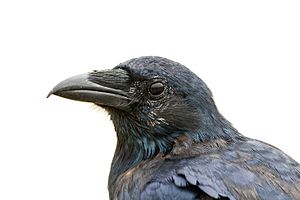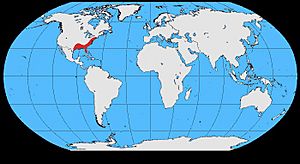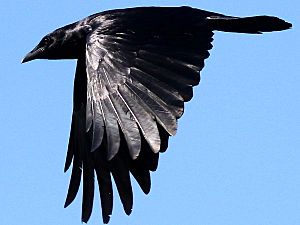Fish crow facts for kids
Quick facts for kids Fish crow |
|
|---|---|
 |
|
| Conservation status | |
| Scientific classification | |
| Genus: |
Corvus
|
| Species: |
ossifragus
|
 |
|
| Fish crow range | |
The fish crow (Corvus ossifragus) is a type of crow that lives near water. You can find them in the eastern and southeastern parts of the United States. They love places like marshes, beaches, and riverbanks.
Contents
Understanding the Fish Crow's Family Tree
Scientists group animals based on how they are related. The fish crow was first described by Alexander Wilson in 1812. Recent genetic tests show that fish crows are closely related to the Sinaloa crow and the Tamaulipas crow. They are not as closely related to the American crow as people once thought.
What Does a Fish Crow Look Like?
Fish crows look a lot like American crows. However, fish crows are a bit smaller. They are usually about 36 to 41 centimeters (14 to 16 inches) long. Their feathers also look smoother and silkier.
Their upper feathers have a blue or blue-green shine. The feathers underneath are more greenish-black. Their eyes are dark brown. It can be hard to tell them apart from American crows unless they are side by side.
Fish crows often have thinner bills and feet. Sometimes, their upper bill has a small, sharp hook at the end. When they walk, their legs might look shorter than an American crow's. When a fish crow calls, it often hunches its body and fluffs up its throat feathers.
How to Tell Fish Crows Apart by Their Voice
The easiest way to tell a fish crow from an American crow is by its voice. A fish crow's call sounds nasal, like "ark-ark-ark" or "waw-waw."
American crows make a distinct "caw caw" sound. Many bird watchers remember this difference with a funny saying. They say, "Just ask him if he is an American crow. If he says 'no,' he is a fish crow." This helps them remember the fish crow's "nyuh unh" sound.
Where Do Fish Crows Live?
Fish crows live along the eastern coast of the United States. Their range stretches from Rhode Island down to Key West. They also live along the northern coast of the Gulf of Mexico.
These birds follow many river systems far inland. They like coastal marshes, beaches, rivers, and inland lakes. You will often find them near river banks and the land right next to water.
Fish Crow Behavior and Habits
What Do Fish Crows Eat?
Fish crows are omnivores, meaning they eat both plants and animals. They usually find food on the ground or in shallow water. They might hover over the water and grab food with their feet.
Their diet includes small crustaceans like crabs and shrimps. They also eat other small creatures without backbones. Fish crows enjoy stranded fish and can catch live fish if it's easy. They also eat bird eggs and baby birds. Fruits, peanuts, and grains are also on their menu. They will even eat human food scraps if they find them.
Fish Crow Reproduction and Nests
Fish crows usually build their nests high up in trees. Often, you'll find several fish crow nests in nearby trees. They form small, loose groups.
Female fish crows usually lay four or five eggs. These eggs are pale blue-green in color. They have olive-brown blotches on them.
Fish Crow Conservation Status
Fish crows seem to be more resistant to West Nile virus than American crows. This means they are better at fighting off the virus. Studies have shown that up to 45% of fish crows can survive the virus. American crows, however, have almost no chance of survival if they get it.
| Wikisource has the text of a 1905 New International Encyclopedia article about Fish crow. |
- Citizen science observations for Fish crow at iNaturalist
Images for kids
See also
 In Spanish: Cuervo pescador para niños
In Spanish: Cuervo pescador para niños





